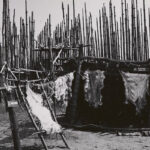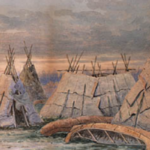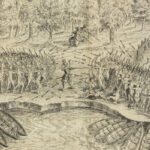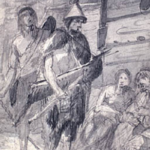Anishinaabe Nation (Union of Ontario Indians): A Legacy of Resilience and Cultural Continuity
The Anishinaabe Nation, as represented by the Union of Ontario Indians (UOI), is one of Canada’s most historically significant Indigenous groups. Encompassing the Ojibwe, Odawa, and Potawatomi peoples, the Anishinaabe have shaped the cultural, spiritual, and political landscape of the Great Lakes region for centuries. From their pre-contact origins to their evolving relationships with European settlers and their modern development, the story of the Anishinaabe Nation is one of resilience, adaptability, and a profound connection to the land.
Pre-History: Anishinaabe Origins and the Great Migration
The Anishinaabe people trace their origins to the Atlantic coast of North America, embarking on a spiritual and physical journey westward under the guidance of the Seven Fires Prophecy. This prophecy, rooted in Anishinaabe oral tradition, foretold a migration to a land where “food grows on water,” a reference to the wild rice that flourished in the Great Lakes region.
By the 16th century, the Anishinaabe had established themselves around the Great Lakes, including present-day Ontario. The Three Fires Confederacy, a powerful alliance of the Ojibwe, Odawa, and Potawatomi, emerged as a unifying force, promoting trade, diplomacy, and cultural exchange among the Anishinaabe and neighbouring nations.
The Anishinaabe’s deep connection to the land and waterways defined their way of life. They relied on the Great Lakes for fishing, hunting, and transportation, while the surrounding forests provided game, berries, and medicinal plants. Their spiritual practices and ceremonies, such as the Midewiwin (Grand Medicine Society), were deeply tied to the natural world, reflecting a worldview that emphasised balance and respect for all living beings.
Anthropologist Robin Ridington, in Trail to Heaven: Knowledge and Narrative in a Northern Native Community, observes, “The Anishinaabe’s relationship with the land was not merely practical but deeply spiritual, forming the foundation of their cultural identity.”
Governance and Social Structure
The governance of the Anishinaabe Nation was rooted in consensus, collective responsibility, and respect for individual autonomy. Chiefs and clan leaders were chosen for their wisdom and ability to guide their people through challenges, while elders played a central role in preserving oral traditions and spiritual teachings.
The clan system, or dodem, provided the social framework for the Anishinaabe. Each clan had specific roles and responsibilities, from leadership to healing, ensuring a balanced and harmonious community. Seasonal gatherings and ceremonies reinforced these bonds, fostering unity and resilience.
Historian Basil Johnston, in Ojibway Heritage, writes, “The Anishinaabe’s social and spiritual systems reflected a profound understanding of human relationships and their connection to the natural world.”
First Contact with Europeans
The arrival of French explorers in the early 17th century marked the beginning of sustained contact between the Anishinaabe and Europeans. The fur trade became the cornerstone of these interactions, with the Anishinaabe acting as trappers, guides, and intermediaries between European merchants and more remote Indigenous nations.
The French introduced goods such as firearms, metal tools, and textiles, which were eagerly adopted by the Anishinaabe. However, these exchanges also brought challenges, including the overharvesting of fur-bearing animals and the introduction of European diseases like smallpox, which devastated Indigenous populations.
The French also brought Jesuit missionaries, who sought to convert the Anishinaabe to Christianity. While some Anishinaabe adopted aspects of Christianity, many incorporated these teachings into their existing spiritual practices rather than abandoning their traditional beliefs.
The Anishinaabe and British Settlers
As British settlers expanded into the Great Lakes region in the 18th century, the Anishinaabe navigated complex relationships with colonial powers. They played a pivotal role in military conflicts, such as the Seven Years’ War (1756–1763) and the American Revolutionary War (1775–1783), aligning with the French or British as circumstances dictated. These alliances were forged out of mutual need, with the Anishinaabe seeking to protect their lands and sovereignty.
Following the American Revolution, the influx of Loyalist settlers into Ontario increased pressure on Anishinaabe lands. Treaties, such as the Robinson Treaties (1850), were negotiated to establish boundaries and secure peace, but these agreements often favoured settler interests. The Anishinaabe ceded vast tracts of land in exchange for annuities, hunting and fishing rights, and promises of protection, many of which were not upheld.
Development Under the Reserve System
The establishment of reserves under the Indian Act (1876) confined Anishinaabe communities to small portions of their traditional territories, disrupting their access to resources and sacred sites. The reserve system was accompanied by policies of assimilation, including residential schools, which sought to erase Indigenous languages and cultures.
Despite these challenges, the Anishinaabe maintained their identity through oral traditions, ceremonies, and resistance. The Union of Ontario Indians, established in 1949, became a vital organisation for advocating Anishinaabe rights, fostering cultural revitalisation, and supporting governance rooted in Anishinaabe traditions.
Cultural Resilience and Revitalisation
The Anishinaabe Nation, as represented by the Union of Ontario Indians, has demonstrated remarkable resilience in preserving their culture and adapting to the challenges of colonisation. Efforts to revitalise Anishinaabemowin (Ojibwe language) and restore traditional practices, such as wild rice harvesting, drumming, and storytelling, have been central to their resurgence.
Annual gatherings, such as powwows, bring communities together to celebrate Anishinaabe traditions through dance, music, and spiritual practices. These events foster unity within the nation and provide opportunities for cultural exchange with neighbouring communities.
Chief Glen Hare, Grand Council Chief of the Anishinabek Nation, stated in a 2020 address, “Our strength lies in our connection to our land, our language, and our traditions. By honouring these, we are building a future that respects our past and empowers our people.”
Environmental Stewardship and Advocacy
The Anishinaabe have long been stewards of the lands and waterways of Ontario. Their traditional ecological knowledge has guided sustainable practices in fishing, hunting, and resource management. In recent decades, the Union of Ontario Indians has taken a leading role in addressing environmental challenges, such as the protection of water quality and the impacts of climate change.
Partnerships with local governments and environmental organisations have advanced these efforts, ensuring that the natural resources of the Great Lakes region are preserved for future generations.
Anishinaabe Nation Today
Today, the Anishinaabe Nation, through the Union of Ontario Indians, represents over 60,000 members from 39 First Nations across Ontario. The organisation supports governance, education, and cultural initiatives, blending traditional practices with modern approaches to community development.
The Union of Ontario Indians continues to advocate for treaty rights, land claims, and environmental justice, reflecting the enduring strength and adaptability of the Anishinaabe people. Their efforts have made significant contributions to reconciliation and the preservation of Indigenous heritage within Canada.
Conclusion: A Legacy of Resilience and Renewal
The history of the Anishinaabe Nation, as represented by the Union of Ontario Indians, is a testament to their resilience, adaptability, and enduring connection to the land. From their ancient traditions and relationships with European settlers to their modern efforts in cultural revitalisation and advocacy, the Anishinaabe have maintained their identity and place within Canada’s evolving landscape.
As Grand Council Chief Glen Hare stated, “We are the keepers of our stories, our land, and our traditions. By honouring our past, we are shaping a future where the Anishinaabe Nation can thrive.”
References
- Ridington, Robin. Trail to Heaven: Knowledge and Narrative in a Northern Native Community. Douglas & McIntyre, 1988.
- Trigger, Bruce G. Indigenous Peoples of Canada. McGill-Queen’s University Press, 1992.
- Johnston, Basil. Ojibway Heritage. McClelland & Stewart, 1976.
- Conrad, Margaret. A Concise History of Canada. Cambridge University Press, 2012.
- Harris, Cole. The Resettlement of British Columbia: Essays on Colonialism and Geographical Change. UBC Press, 1997.
- Union of Ontario Indians. Guardians of the Lakes: The History and Culture of the Anishinaabe Nation. Union of Ontario Indians Publications, 2015.
- Hare, Glen. “Our Path Forward: An Address by the Grand Council Chief.” CBC News, 2020.
- Treaty Elders of Ontario. Voices of the Lakes: Stories from Anishinaabe Communities. University of Toronto Press, 2005.
- Environmental Justice Advocacy Group. Stewardship and Sustainability: The Role of the Anishinaabe Nation in Environmental Advocacy. University of Guelph Press, 2018.
- Williams, Dorothy. Treaties and Traditions: The Legacy of the Anishinaabe Nation. University of Toronto Press, 2009.



